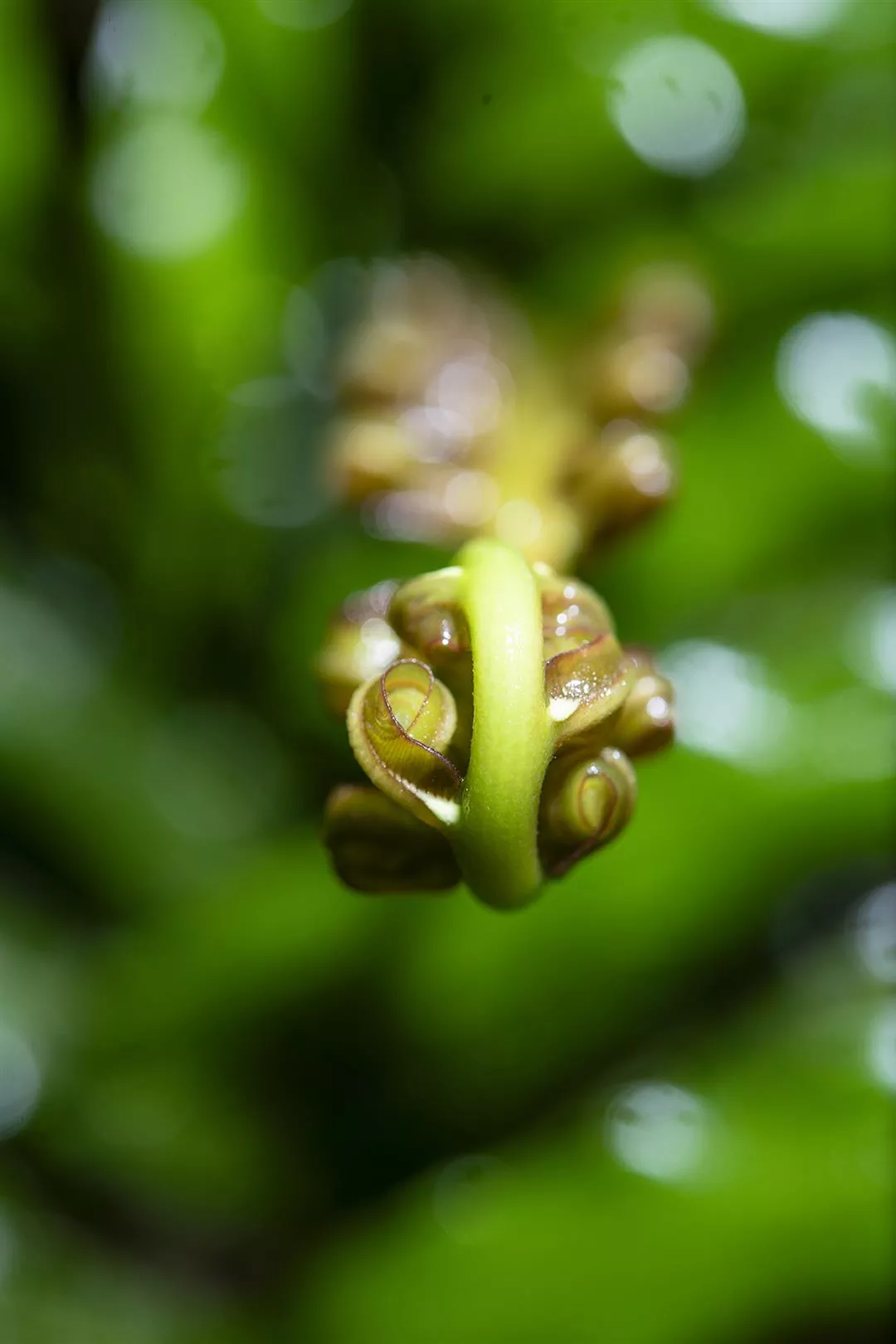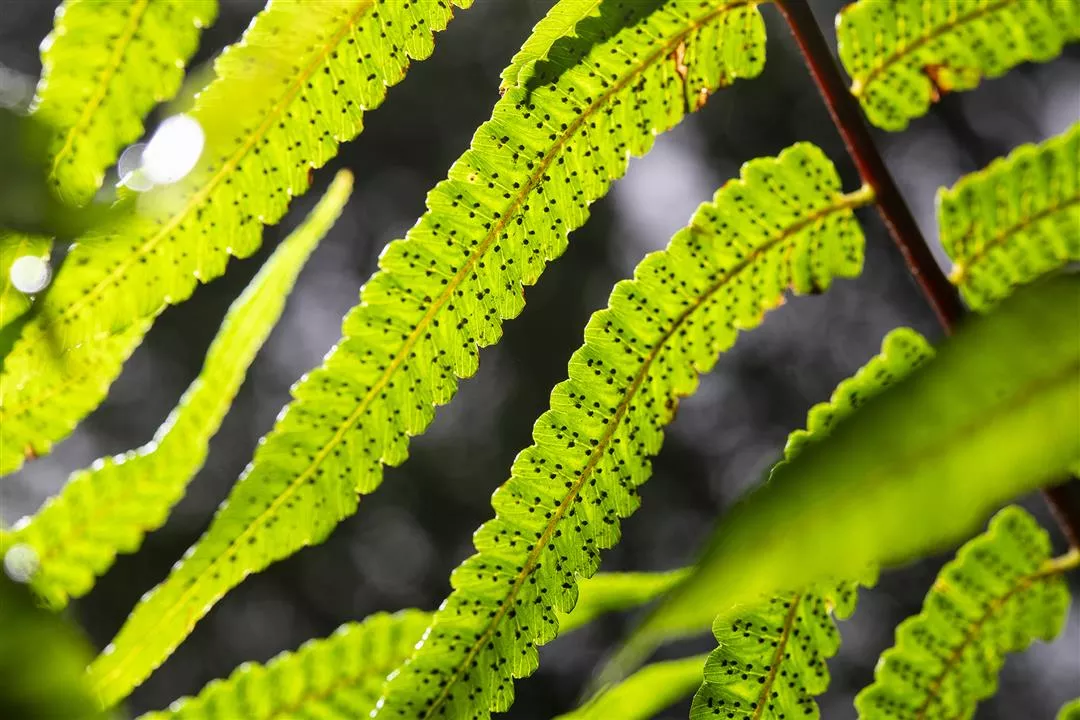Plant Masters of the Jurassic:
Tree Ferns in Taiwan
Cindy Li / photos by Kent Chuang / tr. by Phil Newell
November 2024

The fronds of tall tree ferns form overhead feather-shaped umbrellas in the forest. This is a collective memory shared by mankind and the dinosaurs.
Ferns, which have been called “living fossils,” reveal the powerful resilience and adaptability of ancient life forms. Among them, tree ferns, which are perfectly adapted to local conditions in Taiwan, are an everyday sight on the island. They also offer a precious travel experience to visitors from around the world.
Walking the Jingualiao Fish and Fern Trail in New Taipei’s Pinglin District, one can hear the mountain stream rushing by and touch the various plants growing along the winding cliff face. Amid the common broadleaved vegetation, tall plants—the flying spider-monkey tree fern and the spiny tree fern—hold up question-mark-shaped “croziers” at the ends of their young fronds to greet us as we pass.
Tree ferns, which rival ordinary trees in height, were once the masters of the forest. In the Jurassic period they grew 20‡40 meters tall, large enough to block out the sky. Even dinosaurs could only pass beneath them. Today, as we visit Pinglin, their feather-shaped fronds form parasols overhead.

to tell tree ferns apart from most seed-bearing plants is by their distinctive feather-shaped fronds, made up of compound leaves.
Living fossils
Amongst ferns, which grow mainly as herbs, creepers or shrubs, tree ferns stand out for their height, and have long attracted the attention of scientists. They are thought to preserve the forms and characteristics of ferns from days long past, and are therefore called “living fossils.”
After the emergence of spermatophytes (seed-bearing plants) about 200 million years ago (in the Triassic to the Jurassic periods), tree ferns were unable to compete with them, and the number of species steadily declined. Therefore, concludes Kuo Chen-meng, president of the Taiwan Ecotourism Association: “Today if you travel to countries around the world your chances of seeing tree ferns are very low.”
This is even more true because of the stringent habitat requirements for tree ferns: They can only grow in tropical rainforests amid misty surroundings at elevations of 2,000‡3,000 meters.
One of the most representative tree fern species in Taiwan is the flying spider-monkey tree fern (Cyathea lepifera), also known as the brush pot tree. It is found in the rugged terrain of Northern Taiwan, where there is plentiful moisture brought by the northeasterly monsoon winds and ocean currents, and no distinct dry periods. These conditions have given rise to a rare subtropical forest with an abundance of flying spider-monkey tree ferns, that is a global center of this species.
Comparing this with regions at similar latitudes around the world, including the Sahara Desert, North Africa, and northern Mexico, these latter areas do not have environments conducive to the growth of ferns. “That’s why I say the environment of Greater Taipei and Yilan is extremely rare anywhere in the world,” says Kuo.

when old fronds fall are the reason why the flying spider-monkey tree fern is also known as the “snake tree.” (photo by Jimmy Lin)

In the suburban mountain areas of Northern Taiwan one can see tree ferns such as the spiny tree fern and flying spider-monkey tree fern everywhere.

One can identify tree ferns at first glance by their distinctively shaped fronds.
All in the Cyatheaceae family
When you encounter tree ferns in the low-elevation forests of Northern Taiwan, at first glance they look similar to seed-bearing trees. But if you look closely, you can see many differences.
In sunny, damp areas throughout Taiwan one can see the flying spider-monkey tree fern that is so common in Northern Taiwan. The question-mark-shaped “croziers”—the furled tips of young fronds, covered with golden-yellow scales—are an identifying characteristic of this species. The large feather-shaped fronds, which can grow up to three meters in length, fall off after they age, leaving oval scars on the tree trunks that are like a beautiful snakeskin pattern, which is why they are known to the Japanese as “snake trees.” This is the tree fern species that foreign visitors to Taiwan find to be the most breathtaking.
The spiny tree fern (Cyathea spinulosa), which is often mistaken for the flying spider-monkey tree fern, is the second most common tree fern in Taiwan, and is found at middle to low elevations. The quickest way to identify this species, besides the tan coloring at the top of the stem, is to check out the old fronds, which hang down in a circle around the canopy because the plant has no mechanism for shedding them. This is why many hikers describe these tree ferns as “dancers wearing grass skirts.” Kuo Chen-meng explains that this characteristic is in fact a survival mechanism, developed to prevent vines from climbing up the plants.
The Cyatheaceae family in Taiwan also includes Cyathea podophylla, which has a relatively sparse “skirt” and is somewhat shorter; Cyathea fenicis, whose appearance and ecological role are similar to those of the spiny tree fern on Taiwan proper, but which grows only in the Datian Lake area of Lanyu (Orchid Island); the toothed black tree fern (Cyathea hancockii), which was carried southward by the wind to Northern Taiwan’s Datun Mountains, providing evidence for the notion that Taiwan has an ecological “north-facing slope”; and Cyathea loheri, which looks identical to the flying spider-monkey tree fern but prefers a tropical rainforest climate and is found only around Jinshuiying on the border between Pingtung and Taitung Counties.
It’s worth mentioning that the spiny tree fern, which comes from the same family, is similar in appearance to Cyathea podophylla, but is shorter. Like the toothed black tree fern, it is one of the few members of the Cyatheaceae family that do not grow as trees.


The varied terrain of Greater Taipei and Yilan, along with the most, misty environment, make this region an ideal habitat for tree ferns.

Looked at from different angles, ferns’ unique “croziers”—the swirl-shaped sprouts of new fronds—offer different visual experiences to the viewer.
“Are Taiwanese all nouveau riche?”
People in Taiwan can easily see tree ferns along the island’s hiking trails, but internationally they are rare plants, and the flying spider-monkey tree fern in particular is protected in many countries.
The Convention on International Trade in Endangered Species of Wild Fauna and Flora (CITES) lists all ferns of the Cyatheaceae family worldwide as controlled under Appendix 2 of the convention. The plants or their products can only be traded internationally with a CITES permit.
In Taiwan, we are accustomed to living amongst these tree ferns. They are familiar to us, and we have a long history of using them as natural raw materials. For example, the dense aerial roots of the flying spider-monkey tree fern have been harvested and turned into boards and posts for cultivating orchids. Providing good drainage and ventilation, they are seen as an outstanding growth medium. And in the past there were businesses in Wulai that used the uniquely patterned stem of the flying spider-monkey tree fern to make writing-brush holders that were very popular with Japanese tourists.
In days gone by, farmers in Northern Taiwan would cut free the frond stems of flying spider-monkey tree ferns and bind them together into rectangular boards which were used as natural kitchen graters to mash sweet potatoes.
Foreigners might find such facts to be astonishing. “I had a colleague from the University of Zurich who came to Taiwan. When we were driving past a vegetable market, he saw a fern-root orchid post that had been cast aside at the roadside, and he immediately asked me to stop the car so he could pick it up and take it home,” says Kuo Chen-meng, adding that the sight of his colleague rummaging through a roadside garbage pile was unforgettable.
Another time, when he was working at the Berlin Botanic Garden and Botanical Museum in Germany, he was asked by a colleague: “Are Taiwanese all nouveau riche?” This made him realize that in the eyes of this foreigner, Taiwanese people’s comprehensive use of flying spider-monkey tree ferns, ancient plants dating back to the Jurassic period, appeared extremely extravagant.

The black spots appearing on the leaves of ferns are the main means by which these plants reproduce: spores.

Kuo Chen-meng, president of the Taiwan Ecotourism Association, has transplanted a piece of Taiwan’s mountain forests into an urban business district, recreating a scene from the Jurassic period. (photo by Jimmy Lin)
Another take on tree fern wilt disease
However, natural resources are not inexhaustible. Challenges including climate change are producing subtle changes in tree ferns’ natural environment that should alert us to trouble.
Since 2006, the Taiwan Forestry Research Institute (TFRI) of the Ministry of Agriculture has continually received reports from the public about mass die-offs of flying spider-monkey tree ferns. This phenomenon has spread from Northern Taiwan throughout the island and even to Lanyu, with reports reaching a peak in 2011.
In 2011 Taiwan Panorama interviewed TFRI researcher Fu Chuen-hsu to get an in-depth understanding of the causes behind this catastrophe for Taiwan’s tree ferns.
The tree fern wilt disease that was sweeping Taiwan attracted attention from the public, giving rise to a movement to protect these plants, and prompting the TFRI to launch an unprecedented “ark program.” Under the plan, spores of the flying spider-monkey tree fern were stored in a germplasm bank until the reason for the plants’ withering could be figured out. The pathogen was found to be an ascomycetous fungus spread by weevils, and the TFRI followed up by continually monitoring tree fern populations in the wild.
But Kuo Chen-meng has a different take on the disease outbreak. He begins by arguing that the Jurassic period had a very misty and foggy environment that provided the high levels of moisture that enabled scaly tree ferns to survive hundreds of millions of years ago. “For them, the key to their continued existence was that the air around the tops of their stems had to remain at a humidity level of nearly 100%, because that is where their cells divide, allowing them to grow robustly.” He then cites the example of the maidenhair fern (Adiantum capillus-veneris), a plant that Taiwanese like to cultivate in and around their homes, noting that even with frequent watering, if the humidity in the air is not high enough the fern will take on a dispirited appearance. But if one encloses the plant in a plastic bag, it will immediately be revitalized thanks to the increase in moisture.
Kuo surmises that in recent years flying spider-monkey tree ferns may have been weakened by a decline in moisture in their environment, perhaps caused by factors such as dry foehn winds brought by typhoons, making them more vulnerable to insects and fungi, and this led to the mass die-offs. “When I went to look at the flying spider-monkey tree ferns back then, the large ones had indeed all died, but the smaller ones were thriving.” Kuo points out that moisture declines with height, so the shorter plants had adequate moisture and remained healthy and strong enough to survive the wave of disease.
Kuo adds that microorganisms are always present in the environment, and the weevils did not appear overnight either. It was certainly the case, he opines, that airborne pathogens led to continual deaths among large tree ferns in the wild, and images of large numbers of dead plants were shocking. “However, tree ferns have been around for a long time and they have their own ways to acclimatize and adapt.” He says with a smile that ferns have outlived the dinosaurs and are a fantastic example of the adage “life will find a way.”

When strolling through Taiwan’s mountain forests, be sure to keep an eye out for tree ferns and their “question-mark” croziers.



@List.jpg?w=522&h=410&mode=crop&format=webp&quality=80)
@List.jpg?w=522&h=410&mode=crop&format=webp&quality=80)


